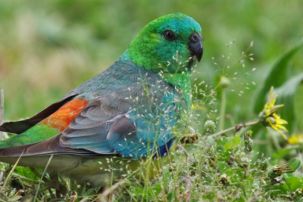Lesson summary
In this activity students explore the positive and negative impacts of climate change on biodiversity. Students work in groups to investigate the impacts on five animals – Yellow-footed Rock-wallaby, Giant Gippsland Earthworm, Common Clownfish, Southern Corroboree Frog and Regent Honeyeater – and create a fact sheet describing the impacts on these animals.
Learning intentions:
Students will...
- understand that climate change will have both negative and positive impacts on biodiversity
- recognise that most climate change impacts on biodiversity are negative
- understand that biodiversity is vulnerable to numerous types of climate change impacts
- understand that there are actions we can take to help biodiversity cope with the impacts from climate change.
Lesson guides and printables
Lesson details
Curriculum mapping
Australian curriculum content descriptions:
Year 9 Science:
- Ecosystems consist of communities of interdependent organisms and abiotic components of the environment; matter and energy flow through these systems (ACSSU176)
- Critically analyse the validity of information in secondary sources and evaluate the approaches used to solve problems (ACSIS172)
- Communicate scientific ideas and information for a particular purpose, including constructing evidence-based arguments and using appropriate scientific language, conventions and representations (ACSIS174)
Year 10 Science:
- Global systems, including the carbon cycle, rely on interactions involving the biosphere, lithosphere, hydrosphere and atmosphere (ACSSU189)
- Critically analyse the validity of information in secondary sources and evaluate the approaches used to solve problems (ACSIS206)
- Communicate scientific ideas and information for a particular purpose, including constructing evidence-based arguments and using appropriate scientific language, conventions and representations (ACSIS208)
Year 10 Geography:
- The human-induced environmental changes that challenge sustainability (ACHGK070)
- The application of human-environment systems thinking to understanding the causes and likely consequences of the environmental change being investigated (ACHGK073)
- Present findings, arguments and explanations in a range of appropriate communication forms selected for their effectiveness and to suit audience and purpose, using relevant geographical terminology and digital technologies as appropriate (ACHGS079)
- Reflect on and evaluate the findings of the inquiry to propose individual and collective action in response to a contemporary geographical challenge, taking account of environmental, economic and social considerations; and explain the predicted outcomes and consequences of their proposal (ACHGS080)
Syllabus outcomes: GE5-2, GE5-3, GE5-8, SC5-7WS, SC5-8WS, SC5-9WS, SC5-14LW, SC5-12ES.
Time required: This activity can be extended over several sessions
Level of teacher scaffolding: Low – oversee activity, facilitate discussion.
Resources required
- Internet access, student worksheet
- Materials for making fact sheet/poster
- PowerPoint
Additional info
This is an original Cool.org lesson. Facts and figures in these lessons may have changed since this lesson was published. We always endeavour to update our resources in a timely manner, but if you see an error or issue in our resources please get in touch with us.


Welcome back!
Don't have an account yet?
Log in with:
By signing up to Cool.org you consent and agree to Cool's privacy policy to
store, manage and process your personal information. To read more, please see
our privacy policy here(Opens in new tab).
Create your free Cool.org account.
Many of our resources are free, with an option to upgrade to Cool+ for premium content.
Already have an account?
Sign up with:
By signing up to Cool.org you consent and agree to Cool's privacy policy to
store, manage and process your personal information. To read more, please see
our privacy policy here(Opens in new tab).